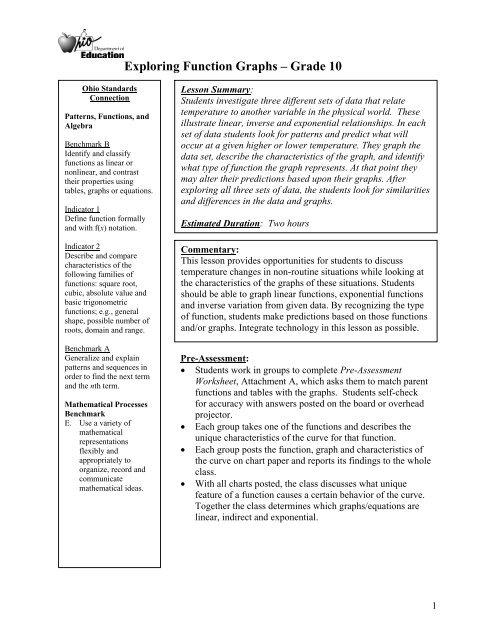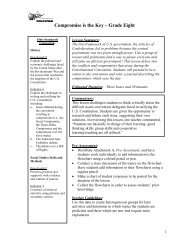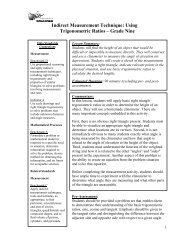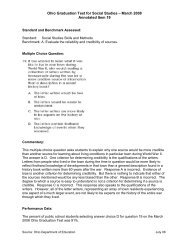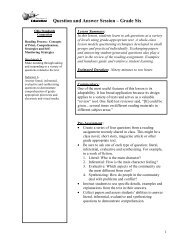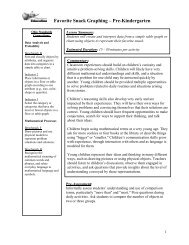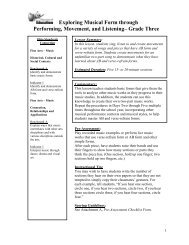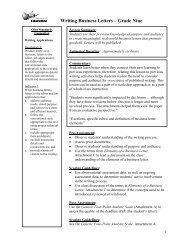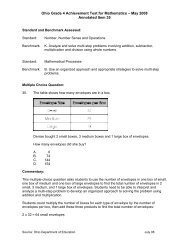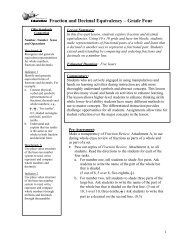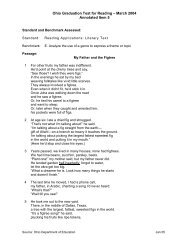Exploring Function Graphs â Grade 10 - ODE - Ohio Department of ...
Exploring Function Graphs â Grade 10 - ODE - Ohio Department of ...
Exploring Function Graphs â Grade 10 - ODE - Ohio Department of ...
You also want an ePaper? Increase the reach of your titles
YUMPU automatically turns print PDFs into web optimized ePapers that Google loves.
<strong>Exploring</strong> <strong>Function</strong> <strong>Graphs</strong> – <strong>Grade</strong> <strong>10</strong>1<strong>Ohio</strong> StandardsConnectionPatterns, <strong>Function</strong>s, andAlgebraBenchmark BIdentify and classifyfunctions as linear ornonlinear, and contrasttheir properties usingtables, graphs or equations.Indicator 1Define function formallyand with f(x) notation.Indicator 2Describe and comparecharacteristics <strong>of</strong> thefollowing families <strong>of</strong>functions: square root,cubic, absolute value andbasic trigonometricfunctions; e.g., generalshape, possible number <strong>of</strong>roots, domain and range.Benchmark AGeneralize and explainpatterns and sequences inorder to find the next termand the nth term.Mathematical ProcessesBenchmarkE. Use a variety <strong>of</strong>mathematicalrepresentationsflexibly andappropriately toorganize, record andcommunicatemathematical ideas.Lesson Summary:Students investigate three different sets <strong>of</strong> data that relatetemperature to another variable in the physical world. Theseillustrate linear, inverse and exponential relationships. In eachset <strong>of</strong> data students look for patterns and predict what willoccur at a given higher or lower temperature. They graph thedata set, describe the characteristics <strong>of</strong> the graph, and identifywhat type <strong>of</strong> function the graph represents. At that point theymay alter their predictions based upon their graphs. Afterexploring all three sets <strong>of</strong> data, the students look for similaritiesand differences in the data and graphs.Estimated Duration: Two hoursCommentary:This lesson provides opportunities for students to discusstemperature changes in non-routine situations while looking atthe characteristics <strong>of</strong> the graphs <strong>of</strong> these situations. Studentsshould be able to graph linear functions, exponential functionsand inverse variation from given data. By recognizing the type<strong>of</strong> function, students make predictions based on those functionsand/or graphs. Integrate technology in this lesson as possible.Pre-Assessment:• Students work in groups to complete Pre-AssessmentWorksheet, Attachment A, which asks them to match parentfunctions and tables with the graphs. Students self-checkfor accuracy with answers posted on the board or overheadprojector.• Each group takes one <strong>of</strong> the functions and describes theunique characteristics <strong>of</strong> the curve for that function.• Each group posts the function, graph and characteristics <strong>of</strong>the curve on chart paper and reports its findings to the wholeclass.• With all charts posted, the class discusses what uniquefeature <strong>of</strong> a function causes a certain behavior <strong>of</strong> the curve.Together the class determines which graphs/equations arelinear, indirect and exponential.
<strong>Exploring</strong> <strong>Function</strong> <strong>Graphs</strong> – <strong>Grade</strong> <strong>10</strong>2Instructional Tip:Point out the difference between a linear relationship with negative slope and a relationship <strong>of</strong>indirect variation, as necessary.Scoring Guidelines:This pre-assessment does not need to be scored. Review parent functions and determine ifstudents have a good understanding <strong>of</strong> the graphs. Check the matching worksheet, monitor foraccuracy in the group reports, and conduct a class discussion to determine if intervention isnecessary before proceeding with the lesson.Post-Assessment:Students work individually to investigate two sets <strong>of</strong> real data, predict new data points anddetermine what type <strong>of</strong> function each represents.• Distribute Post-Assessment Worksheet, Attachment B, to students. This contains two sets <strong>of</strong>data: (1) the number <strong>of</strong> cricket chirps vs. temperature and (2) cold drink temperature vs. time.Ask students to make predictions for points not in the table.• Students look at the data, generate a graph <strong>of</strong> the data and determine what type <strong>of</strong> functionthe data represents.• Students justify their decisions with written explanations.Scoring Guidelines:Rubric for each set <strong>of</strong> data:4 The student correctly• predicts new data points;• identifies the function represented; and• demonstrates an understanding <strong>of</strong> the function in written explanation.3 The student completes 2 <strong>of</strong> the 3 objectives above.2 The student completes 1 <strong>of</strong> the 3 objectives above.1 The student shows some understanding <strong>of</strong> the function.Instructional Procedures:1. Give students the three data sets, Lesson Worksheet, Attachment C. Have students work ingroups to investigate three different sets <strong>of</strong> data: (1) water temperature vs. ocean depth, (2)c<strong>of</strong>fee temperature vs. time, and (3) temperature vs. elevation on a mountain. Ask them toobserve and discuss each data set and its characteristics, as well as generate a graph <strong>of</strong> thedata set. Graph paper or graphing calculators may be used, depending on student’sbackground and availability <strong>of</strong> technology. These are examples <strong>of</strong> direct variation (linearfunction), inverse variation and an exponential function.Instructional Tip:It may be necessary to discuss how to identify independent and dependent variables before thegraphing is done.2. Have students complete Part One for each <strong>of</strong> the three data sets.
<strong>Exploring</strong> <strong>Function</strong> <strong>Graphs</strong> – <strong>Grade</strong> <strong>10</strong>3Instructional Tips:• Students with complete understanding will organize and present their graphs and answers bytheir own method <strong>of</strong> choice.• Optional worksheets, Lesson Problem #1, Attachment D; Lesson Problem #2, Attachment Eand Lesson Problem #3, Attachment F, are for those students who need help in organizingtheir thoughts or for each group to use for reporting.3. Have students write a reflection demonstrating what they have learned about direct, inverseand exponential relationships. Be sure they include similarities and differences between thedifferent functions and their graphs.Differentiated Instructional Support:Instruction is differentiated according to learner needs, to help all learners either meet the intent<strong>of</strong> the specified indicator(s) or, if the indicator is already met, to advance beyond the specifiedindicator(s).• Organize groups to allow all students to contribute according to their strengths and learnfrom others according to their needs.• All students should be able to name the function and talk about the characteristics <strong>of</strong> thegraph. Expect varying levels <strong>of</strong> reasoning in connecting the graph to the nuances <strong>of</strong> the data,connecting the graph to the problem situation and in comparing the functions to each other.• Differentiation can occur in the homework. (See Home Connection)Extensions:• The same procedures in this lesson can be used in the future study <strong>of</strong> new functions, i.e.,cubic, quadratic, square root.• Students can predict an equation that would model the data given for each function and testtheir prediction.Home Connection:• If some students have difficulty interpreting tables and graphing, additional practice could begiven as homework.• For students that have already mastered recognizing the three types <strong>of</strong> functions fromequations, tables and graphs, their homework could be to find additional data setsrepresenting relationships.Interdisciplinary Connections:ScienceStandard: Scientific InquiryBenchmark(s):A. Participate in and apply the processes <strong>of</strong> scientific investigation to create models and todesign, conduct, evaluate, and communicate the results <strong>of</strong> these investigations.
<strong>Exploring</strong> <strong>Function</strong> <strong>Graphs</strong> – <strong>Grade</strong> <strong>10</strong>4Indicator(s):3. Use mathematical models to predict and analyze natural phenomena.4. Draw conclusions from inquiries based on scientific knowledge and principles, the use <strong>of</strong>logic and evidence (data) from investigations.Materials and Resources:The inclusion <strong>of</strong> a specific resource in any lesson formulated by the <strong>Ohio</strong> <strong>Department</strong> <strong>of</strong>Education should not be interpreted as an endorsement <strong>of</strong> that particular resource, or any <strong>of</strong> itscontents, by the <strong>Ohio</strong> <strong>Department</strong> <strong>of</strong> Education. The <strong>Ohio</strong> <strong>Department</strong> <strong>of</strong> Education does notendorse any particular resource. The Web addresses listed are for a given site’s main page,therefore, it may be necessary to search within that site to find the specific information requiredfor a given lesson. Please note that information published on the Internet changes over time,therefore the links provided may no longer contain the specific information related to a givenlesson. Teachers are advised to preview all sites before using them with students.For the teacher: Worksheets, teacher notesFor the student: Worksheets, graph paperVocabulary:• dependent variable• direct variation• domain• exponential decay• exponential growth• function• independent variable• inverse variation• rangeTechnology Connections:Students plot data using a graphing calculator, determine what function the data represents andfind the regression equation for that data set. The equation can then be used to predict a newdata point.Research Connections:Marzano, Robert J., Jane E. Pollock and Debra Pickering. (2001). Classroom Instruction thatWorks: Research-Based Strategies for Increasing Student Achievement. Alexandria, VA:Association for Supervision and Curriculum Development.Novak, Joseph D. (2003, December 19). "The Theory Underlying Concept Maps and How toConstruct Them." Institute for Human & Machine Cognition. University <strong>of</strong> West Florida.http://cmap.coginst.uwf.edu/info/
<strong>Exploring</strong> <strong>Function</strong> <strong>Graphs</strong> – <strong>Grade</strong> <strong>10</strong>5Attachments:Attachment A, Pre-Assessment Worksheet with Answer KeyAttachment B, Post-Assessment Worksheet with Answer KeyAttachment C, Lesson Worksheet with Answer KeyAttachment D, Lesson Problem #1 with Answer KeyAttachment E, Lesson Problem #2 with Answer KeyAttachment F, Lesson Problem #3 with Answer Key
– <strong>Grade</strong> <strong>10</strong>Attachment APre-Assessment WorksheetA. x y-2 0.250 12 44 166 64<strong>Exploring</strong> <strong>Function</strong> <strong>Graphs</strong>6Directions: Match the function with its table and graph.1. y = 2x2. f(x) = 2 x3. y = -2x4. f(x)5. y = 2 -x6. y2=x− 2=xB. x y-2 <strong>10</strong> No sol.2 -14 -.56 -0.333C. x y-2 -40 02 44 86 12D. x y-4 16-2 40 12 0.254 .063E. x y-2 40 02 -44 -86 -12F. x y-2 -<strong>10</strong> No sol.2 14 0.56 0.333
<strong>Exploring</strong> <strong>Function</strong> <strong>Graphs</strong> – <strong>Grade</strong> <strong>10</strong>7Answers:WorksheetAttachment A (continued)Pre-Assessment Worksheet1, C, VI2, A, II3, E, III4, F, V5, D, IV6, B, I1. & 3. Linear2. & 5. Exponential4. & 6. Inverse(form y = ax)(form y = a x )(form y = a x )Possible Answers<strong>Function</strong> DescriptionsExponential <strong>Function</strong>sIs a single curveRises or falls dramaticallyRises when exponent ispositive, falls whenexponent is negativeNever touches the x-axisNever goes below x-axis (yis always positive)Does have a y-intercept(will be 1 unless there is acoefficient )Can represent growth ordecayLinear <strong>Function</strong>sIs a straight lineRises or falls at a constantrate (slope)Rises if coefficient ispositive, falls if coefficientis negativeCrosses the x- and/or y-axisInverse VariationIs made up <strong>of</strong> two curvesthat are symmetricNever crosses the x or y axis(no intercepts)Is positive in Quadrant I ifthe constant (numerator) ispositive, and positive inQuadrant II if the constantis negativeGets very close to zerowhen x is very largepositive or very largenegative.
Attachment BPost-Assessment WorksheetI. The table shows the number <strong>of</strong> cricket chirps in a 15 second interval at various temperatures.Temp ( o F)Chirps per 15 sec<strong>Exploring</strong> <strong>Function</strong> <strong>Graphs</strong> – <strong>Grade</strong> <strong>10</strong>854 1565 2168 2379 3182 3389 381. Construct a graph <strong>of</strong> the data.2. Determine what type <strong>of</strong> function the data represents. Explain how you arrived at your choice.3. Estimate the number <strong>of</strong> chirps in a 15 second interval at 50 o F.4. Estimate the temperature when there are 17 chirps in a 15 second interval.
<strong>Exploring</strong> <strong>Function</strong> <strong>Graphs</strong> – <strong>Grade</strong> <strong>10</strong>Attachment B (continued)Post-Assessment Worksheet0 1143 1587 189II. The table shows the temperature <strong>of</strong> a cold drink sitting out on the counter after the givennumber <strong>of</strong> minutes.Time (min) Temp ( o C)117 19160 20180 201. Construct a graph <strong>of</strong> the data.2. Determine what type <strong>of</strong> function the data represents. Explain how you arrived at your choice.3. Estimate the temperature <strong>of</strong> the drink after 20 minutes.4. Estimate the temperature <strong>of</strong> the drink after 3 hours.
<strong>Exploring</strong> <strong>Function</strong> <strong>Graphs</strong> – <strong>Grade</strong> <strong>10</strong><strong>10</strong>Answer Key:I. Cricket chirps1. Graph <strong>of</strong> data table.Attachment B (Continued)Post-Assessment WorksheetChirpsWINDOWXmin=40Xmax= 92.5Xscl=<strong>10</strong>Ymin=0Ymax=41.91Yscl=5Xres=1Temperature2. The function is linear (direct variation). The graph <strong>of</strong> data points appears to be linear, and theratio <strong>of</strong> the change in temperature to the number <strong>of</strong> chirps is constant.3. The number <strong>of</strong> chirps at a temperature <strong>of</strong> 50 o F is approximately 12 chirps per 15-secondinterval.4. The temperature at 17 chirps per 15-second interval is approximately 58 o F.II. Temperature1. Graph <strong>of</strong> data table.MinutesRoom TemperatureWINDOWXmin=-18Xmax=198Xscl=1Ymin=9.47Ymax=21.53Yscl=5Xres=1Room Temperature2. The function is exponential. The graph rises at first and then levels <strong>of</strong>f to a constant (roomtemperature).3. The temperature after 20 minutes would be approximately 13 o C.4. After 3 hours, the temperature would remain at 21 o C.
<strong>Exploring</strong> <strong>Function</strong> <strong>Graphs</strong> – <strong>Grade</strong> <strong>10</strong>Attachment C11Lesson Worksheet1. The table shows the water temperature at various depths for part <strong>of</strong> the Pacific Ocean.Depth (m) Temp ( o C)750 5<strong>10</strong>00 42500 1.73700 1.24500 12. The table shows the temperature at different elevations on Mt. Everest in June.Height (ft) Temp ( o F)<strong>10</strong>,000 6118,000 25QuickTime and aPhoto - JPEG decompressorare needed to see this picture.24,000 130,000 -273. The table shows the temperature <strong>of</strong> a cup <strong>of</strong> c<strong>of</strong>fee cooling over time.Time (min.) Temp ( o C)0 684 598 5412 5016 4720 45
<strong>Exploring</strong> <strong>Function</strong> <strong>Graphs</strong> – <strong>Grade</strong> <strong>10</strong>Attachment C (continued)Lesson Worksheet12Part OneFor each data set complete the following:1. List characteristics <strong>of</strong> the data.2. Identify the independent and dependent variables for the data set.3. What type <strong>of</strong> relationship do you think the data represents and why?4. Graph the data and describe the graph <strong>of</strong> the data set in your own words. (List as manycharacteristics as possible.)5. What general type <strong>of</strong> function does the data set and its graph represent?6. How does the graph describe the problem situation?7. Give another example in real life that would have the same type <strong>of</strong> graph and explainwhy.Part TwoUsing your graph and knowledge <strong>of</strong> each function, predict the following:Refer to problem #1What will the temperature be at an ocean depth <strong>of</strong> 1500 m?Refer to problem #2At what height on Mt. Everest would the temperature be 40 o F?What would the temperature on Mr. Everest be at a height <strong>of</strong> 7000 ft?Refer to problem #3What would the temperature <strong>of</strong> the c<strong>of</strong>fee be after 30 min?After how many minutes would the c<strong>of</strong>fee be 62 o C?
Attachment C (continued)Lesson WorksheetAnswer KeyPart One#1 Data Set1. As the depth increases, the temperature decreases, but not at a constant rate. The ratio <strong>of</strong> thechange in temperature to change in depth decreases with depth.2. The independent variable is ocean depth and the dependent variable is temperature.3. Inverse relationship4. A curve that is continually decreasingTemperature (ºC)<strong>Exploring</strong> <strong>Function</strong> <strong>Graphs</strong> – <strong>Grade</strong> <strong>10</strong>Depth135. Indirect variation. As one variable decreases, the other continues to decrease at a smaller rate.6. It is getting colder as you go deeper in the ocean.7. (Answers will vary.) As you age, you get shorter.#2 Data Set1. As the height increases, the temperature decreases at a fairly constant rate. The ratio <strong>of</strong> thechange in temperature to change in height is constant.2. The independent variable is height and the independent variable is temperature.3. Direct variation. As one variable increases the other decreases at a constant rate.4. A straight line that is decreasing.Temperature (ºF)Height5. Linear function.6. As you climb the mountain, it is getting colder.7. (Answers will vary.) As you spend money, your bank account decreases.
Attachment C (Continued)Lesson Worksheet#3 Data Set1. As time increases, the temperature decreases at a smaller rate. The ratio <strong>of</strong> the change intemperature to change in time decreases with time.2. The independent variable is time, and the dependent variable is temperature.3. Exponential. As one variable increases, the other decreases dramatically.4. A curve that decreases dramatically at first, and then levels <strong>of</strong>f.Temperature (ºC)<strong>Exploring</strong> <strong>Function</strong> <strong>Graphs</strong> – <strong>Grade</strong> <strong>10</strong>Minutes14Exponential5. As time goes on, the c<strong>of</strong>fee cools and will eventually level <strong>of</strong>f to room temperature.6. (Answers will vary.) Over time the value <strong>of</strong> a car depreciates to $0.Part TwoRefer to problem #1about 2.7 o CRefer to problem #2about 16,000 ftabout 76 o CRefer to problem #335 o C2 min
<strong>Exploring</strong> <strong>Function</strong> <strong>Graphs</strong> – <strong>Grade</strong> <strong>10</strong>Attachment DLesson Problem #1Depth (m) Temp ( o C)750 5<strong>10</strong>00 42500 1.73700 1.24500 115The table shows the water temperature at various depths for part <strong>of</strong> the Pacific Ocean.1. Graph the information in the table on graph paper.2. Give two characteristics <strong>of</strong> the data.3. Identify the independent and dependent variables.4. What type <strong>of</strong> relationship do you think the data represents and why?5. How does the graph describe the problem situation?6. Using your graph and knowledge <strong>of</strong> each function, predict the following:What will the temperature be at an ocean depth <strong>of</strong> 1500m?
Attachment D (continued)Lesson Problem #1Answer Key1. Temperature (ºC)<strong>Exploring</strong> <strong>Function</strong> <strong>Graphs</strong> – <strong>Grade</strong> <strong>10</strong>Depth162. A curve that is continually decreasing.As the depth increases, the temperature decreases, but not at a constant rate.The ratio <strong>of</strong> the change in temperature to change in depth decreases with depth.3. The independent variable is ocean depth and the dependent variable is temperature.4. Inverse relationship5. Indirect variation. As one variable decreases, the other continues to decrease at a smaller rate.It is getting colder as you go deeper in the ocean.6. about 2.7 o C
<strong>Exploring</strong> <strong>Function</strong> <strong>Graphs</strong> – <strong>Grade</strong> <strong>10</strong>Attachment ELesson Problem #2Height (ft) Temp ( o F)<strong>10</strong>,000 6117The table shows the temperature at different elevations on Mt. Everest in June.18,000 25QuickTime and aPhoto - JPEG decompressorare needed to see this picture.24,000 130,000 -271. Graph the information in the table on graph paper.2. Give two characteristics <strong>of</strong> the data.3. Identify the independent and dependent variables.4. What type <strong>of</strong> relationship do you think the data represents and why?5. How does the graph describe the problem situation?6. Using your graph and knowledge <strong>of</strong> each function, predict the following:a. At what height on Mt. Everest would the temperature be 40 o F ?b. What would the temperature on Mt. Everest be at the height <strong>of</strong> 7000 ft?
Attachment E (continued)Lesson Problem #2Answer Key1. Temperature (ºC)Height2. Linear functionA straight line that is decreasingAs the height increases, the temperature decreases at a fairly constant rate.The ratio <strong>of</strong> the change in temperature to change in height is constant.3. The independent variable is height and the independent variable is temperature.<strong>Exploring</strong> <strong>Function</strong> <strong>Graphs</strong> – <strong>Grade</strong> <strong>10</strong>184. Direct variation. As one variable increases the other decreases at a constant rate.5. As you climb the mountain, it gets colder.6. a. about 16000 ftb. about 76 o F
<strong>Exploring</strong> <strong>Function</strong> <strong>Graphs</strong> – <strong>Grade</strong> <strong>10</strong>20Answer KeyAttachment F (continued)Lesson Problem #31. Temperature (ºC)Minutes2. A curve that decreases dramatically at first, and then levels <strong>of</strong>f.As time increases, the temperature decreases at a smaller rate.The ratio <strong>of</strong> the change in temperature to change in time decreases with time.3. The independent variable is time, and the dependent variable is temperature.4. Exponential. As one variable increases, the other decreases dramatically.5. As time goes on, the c<strong>of</strong>fee is cooling and will eventually level <strong>of</strong>f to room temperature.6 a. 35 o Cb. 2 min


